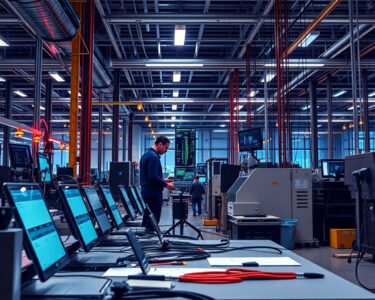Southeast Asia has, over the past decade, become a hotbed of technological innovation, with substantial digital transformation fueling its economic development. This region, with its diverse economies and cultures, is shaping its own digital revolution, and it’s not an exaggeration to say that technology is reshaping everything. From the way people work and shop to how they access healthcare and education, digital advances have started to lift millions out of poverty, bring opportunities to rural areas, and redefine what’s possible in sectors like finance, agriculture, and education.
The impact of technology in Southeast Asia’s economic landscape cannot be overstated. A report by Google, Temasek, and Bain & Company recently projected that Southeast Asia’s digital economy could reach a staggering $1 trillion by 2030. This transformation is driven by a unique combination of factors, including a young and tech-savvy population, rising internet penetration, and increasing mobile phone usage. Nearly every country in the region, from Thailand to the Philippines, is experiencing the benefits of technology-enabled growth, and the effects are beginning to spread across the socioeconomic spectrum.
One of the most visible changes brought by technology in Southeast Asia is the surge in e-commerce. As internet penetration has increased, millions of people in countries like Indonesia, Thailand, and Vietnam are shopping online like never before. While physical infrastructure in some areas still needs improvement, online platforms have become a workaround, offering goods and services to people regardless of their location. For example, Indonesian platforms like Tokopedia and Shopee have not only made it easier for people to shop but also opened up business opportunities for small and medium-sized enterprises that might never have had a chance to reach a national or regional market before. This was especially significant during the COVID-19 pandemic, as lockdowns forced businesses to go digital, accelerating the growth of e-commerce and, in turn, contributing to broader economic growth.
Technology is also reshaping finance in Southeast Asia, where digital payments and financial technology are bridging gaps left by traditional banking systems. The rapid adoption of mobile wallets and digital banking solutions has transformed how people in Southeast Asia handle money. In places like the Philippines, for example, traditional banking services were inaccessible for large portions of the population, particularly in rural areas. With the rise of fintech, however, even those without bank accounts can participate in the digital economy. Platforms like GCash in the Philippines and Momo in Vietnam allow people to make payments, transfer money, and even access financial products like loans and insurance from the convenience of a smartphone. This shift toward digital payments is not only convenient but also promotes financial inclusion, allowing people previously excluded from the formal economy to engage in new economic activities.
Meanwhile, technology is breathing new life into traditional industries like agriculture and manufacturing. Agriculture, a crucial sector for many Southeast Asian economies, is now benefiting from digital tools that optimize production, improve supply chain efficiency, and increase yields. For instance, farmers in Thailand and Vietnam are using smartphone apps to monitor weather patterns, track crop prices, and access information on sustainable farming practices.
These tools enable them to make more informed decisions, reduce waste, and ultimately increase productivity. Similarly, the manufacturing sector is seeing a shift with the integration of automation and data analytics, which are enhancing efficiency and helping Southeast Asian countries stay competitive in a global market. In Malaysia’s Eastern Economic Corridor, for instance, there’s a concerted effort to attract high-tech industries and foster innovation, showcasing how technology can transform not just specific companies but entire regions.
However, the journey toward a fully tech-driven economy in Southeast Asia isn’t without challenges. While cities like Singapore and Kuala Lumpur enjoy high-speed internet and advanced digital infrastructure, large parts of the region still struggle with a digital divide. In many rural areas, particularly in countries like Myanmar and Laos, internet connectivity is limited or even non-existent. This disparity creates unequal access to technology’s benefits, and without significant investment, millions of people could be left behind. Bridging this digital divide is essential to ensure that the entire region can benefit from economic growth spurred by technology. Governments, development agencies, and private companies all have a role to play in expanding internet access, which has the potential to unlock countless opportunities for those living in remote or underserved areas.
Cybersecurity is another pressing issue as Southeast Asia’s digital economy continues to grow. With more businesses and financial transactions moving online, the risk of cyber threats also increases. A single cyberattack can have devastating consequences, not only for individual companies but also for the confidence of consumers and businesses alike in digital platforms. In response, governments across Southeast Asia are starting to implement more stringent cybersecurity regulations and invest in measures to protect data. However, there is still a long way to go, and as more people engage with digital platforms, ensuring robust cybersecurity is critical to sustaining growth and maintaining trust in the digital economy.
One other essential factor in the region’s digital transformation is the need for a tech-savvy workforce. As technology reshapes industries, there is a growing demand for workers skilled in digital tools and platforms. Yet, many educational systems in Southeast Asia have not fully adapted to meet these new requirements. To build a future-ready workforce, Southeast Asia needs to invest in digital literacy and tech-focused education. Programs like Singapore’s SkillsFuture initiative, which offers citizens opportunities to upskill and reskill, are a good example of how governments can prepare their populations for a digital economy. By encouraging a culture of lifelong learning, Southeast Asia can ensure that its workforce remains competitive in an increasingly digital world.
Despite these challenges, the outlook for Southeast Asia’s digital economy is incredibly promising. The region has attracted the attention of major international tech companies, with big players like Google, Amazon, and Oracle investing heavily in local digital infrastructure. These investments reflect the confidence that the global business community has in Southeast Asia’s potential as a tech-driven economy. For instance, Oracle recently announced plans to invest $6.5 billion to establish cloud facilities in Malaysia. This influx of capital and expertise from international companies is not only accelerating the region’s digital transformation but also creating jobs and fostering local innovation. With the right investments and policies, technology can help Southeast Asia create a future that is more inclusive, resilient, and prosperous.



